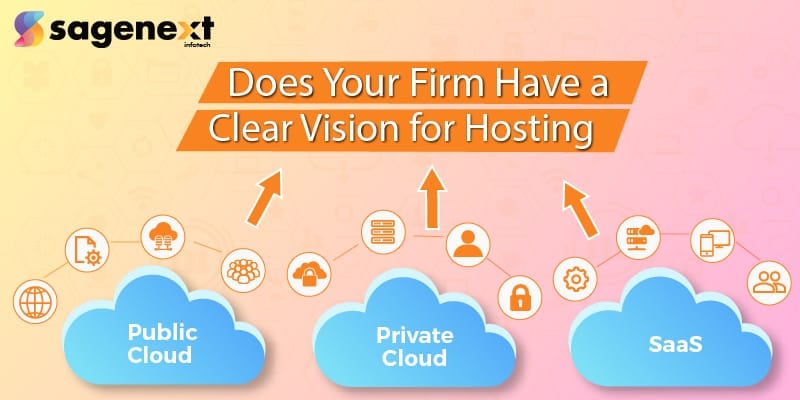
Get the Clear Vision for Hosting: Public Cloud, Private Cloud, And SaaS
The cloud has been the biggest technology enabler amidst the dreadful circumstances of the novel coronavirus. It has helped millions of businesses survive the unfavorable times, providing them the infrastructure required to implement remote working, that too on a scale never heard or attempted in the past.
Even today, the world continues to fight this communicable disease rigorously. Nations across the globe are attempting to recover from the economic slump created by the pandemic. Amidst all this, the cloud stands up and ready for all the assistance on the road to recuperation.
The following are some of the key highlights of a survey conducted by Snow Software after the pandemic struck:
- 82 percent of the surveyed IT leaders have confirmed that they increased their cloud usage as an immediate response to the coronavirus situation.
- 66% of them have said that they see themselves continuing to ramp up their cloud usage in the foreseeable future.
- More than 76 percent of the survey respondents attributed the COVID-19 pandemic for their proliferated spendings on public and private cloud infrastructure.
If you are a business owner, you must be keeping a close eye on these recent developments surrounding cloud computing. It is clear that while organizations are trying to trim other operational costs to compensate for the economic toll they have been subjected to amidst this pandemic, they are not shying away from making significant investments in their cloud strategies. And why not? The cloud not only ensures business continuity in difficult times like these but also offers long-term growth opportunities and stability.
While it may be a no brainer for you, as a business owner, to embrace the cloud with open arms, it is important to understand which cloud infrastructure or service best suits your requirements. A clear cloud strategy or vision will help your firm attain the best efficiency, scalability, agility, and profitability. Before discussing important factors that help you define your cloud vision, it is important to understand various cloud strategies.
Public Cloud
A public cloud is an internet-based shared service model where the hosting services provide shared resources. These resources include servers, storage systems, and applications. In this multi-tenant cloud strategy, a common pool of IT infrastructure is shared amongst different clients.
The shared resources are available on a pay-as-you-go basis for you to use. The strategy is best known for its lower costs, scalability, reliability, and flexibility. Some of the most popular public clouds are Google Cloud Platform, Amazon Web Services (AWS), OpenStack Public Cloud, and Microsoft Azure.
Private Cloud
A private cloud, as its name suggests, is exclusive to a single client or business. In this, all the available resources like servers and databases are private and not shared. It offers superior security to your data and resources.
Private cloud infrastructure is generally preferred by companies dealing with sensitive data. You can either set up an in-house private cloud infrastructure or can host an off-premises, third-party private cloud. The private cloud market is comparatively more diverse. Hewlett Packard Enterprise (HPE), Dell, VMware, Oracle, etcetera are some of the key private cloud providers.
Hybrid Cloud
It is a cloud computing strategy that combines a private cloud with a single or multiple public clouds. It incorporates proprietary applications that permit communications between the private and public clouds. With a hybrid cloud environment, you have the flexibility to store your sensitive information on a more secure private cloud and simultaneously benefit from the strong computational powers of a public cloud.
More and more modern businesses are moving towards a hybrid cloud infrastructure for a superior cloud strategy. It offers security to your private data and simultaneously helps you attain greater cost-efficiency, flexibility, and agility.
Software as a Service (SaaS) Hosting
SaaS is an internet-based hosting solution in which your files and software application are stored on a hosted server. Your users or customers are able to access your application or services via the internet.
SaaS hosting eliminates the requirement for you to manage the infrastructural needs of an in-house application hosting. Moreover, it upgrades the application software in the cloud itself, removing the need for the end-user to download the upgraded application.
Having understood the available cloud hosting options, you can ask yourself relevant questions to decide which strategy best fits your cloud requirements. It is paramount for having a clear vision for hosting. The following are the steps you can follow to help prepare the best cloud strategy for your firm:
-
Identifying Potential Benefits
It is always a good choice to invest in strategies that help your firm grow in the future. A strategic investment now can save you from spending more in putting out the fires caused by persistent ignorance of the market trends later. Cloud computing is one of those technologies you don’t want to ignore. You might be aware of the general benefits that the cloud brings. But, you must know, in specific, about the value it would add to your organization.
-
Outlining Your Cloud Goals
Having identified the specific benefits of the cloud for your business, you must next list your firm’s cloud objectives. It will help you determine your primary drivers for cloud adoption. This can be achieved by revisiting your corporate goals, analyzing present unmet requirements, and identifying your major stakeholders.
You can sit and brainstorm with your firm’s most affected units. This will help you not only summarise your cloud goals but also rank them strategically. For example, your executive unit’s list may look like:
- Faster results,
- Exceptional growth, and
- Cost savings
On the other hand, your IT department’s list may seem like:
- Operational simplicity & cost-efficiency,
- Access to skills and services, and
- Adopting emerging tech
-
Assessment of Your Firm’s Present IT Infrastructure
A readiness assessment helps you determine whether or not your current IT infrastructure is conducive to novel tech adoption. It will help you have a clear roadmap of the necessary changes that you would be required to make in order to build a new cloud infrastructure for your organization.
Here, you would need to ask relevant questions pertaining to your present IT resources. It will help you identify your IT policies and resources that will be conducive to the transition, non-conducive to it, and those that might go obsolete after the transition is achieved.
-
Picking the Accurate Deployment Model
The next step towards attaining a clear cloud vision is to select the cloud deployment model that best suits your business requirements. It is as simple as asking where exactly do you want your business information and computing resources to live.
If your priority is attaining higher elasticity and on-demand access to your resources, you can go for a public cloud. However, you should not be bothered about the security risks that arise because of it being a multi-tenant environment.
If your firm deals with critical information, you might opt for a private cloud deployment model. It is more efficient and secure. However, you should be alright with the scaling limitations and capital intensiveness of this model.
You can choose a hybrid cloud model that offers you the benefits of both the private and the public cloud. That way, you can keep your critical resources local. You would still be required to procure and maintain physical hardware resources. Hence, this model will also be capital intensive.
Similarly, you can evaluate other aspects of these deployment models to determine which of them suits your requirements the best.
-
Choosing the Right Cloud Service
After deciding the best cloud deployment model, you would need to select the right cloud service model. It determines how you manage your cloud services. You can choose between Infrastructure as a Service (IaaS), Platform as a Service (PaaS), and Software as a Service (SaaS).
Every service model provides specific functionalities. It is important for you to understand the distinctions and choose the one that best suits your service needs.
For example, if you prefer direct control over the configuration of applications above anything else, you can go with IaaS. The services are highly scalable, dynamic, and flexible. If you want a well-ordered service model that enables you to create your customized applications, you can choose PaaS. And if you are comfortable with a service that offers no control over the infrastructure, including software, then you may opt for SaaS.
Further, you can deeply analyze all the pros and cons of each of these service models. That way you can identify the best one for your firm.
The aforementioned steps should help you determine the right cloud strategy for your firm. After identifying the accurate cloud model and service, you can align and prioritize your cloud initiatives. It involves identifying target departments and selecting the preferred IT services as cloud candidates.
Further, you can assess the potential risks that the cloud involves. It could be related to security and compliance, resource availability, reliability, data integration, etcetera. The assessment will help you develop measures that will safeguard your information and resources against the underlying threats. That way, you can achieve a great vision for hosting any of the cloud models or services for your firm.
However, if you choose to simply go ahead with any of the models or services blindly, it would count as an inefficient investment where you will fail to optimize your business potential and make your firm vulnerable to the ubiquitous security threats.
A clear cloud vision helps you understand the benefits as well as the expected drawbacks of a particular model you choose. It helps you smoothly migrate to the chosen cloud model that will help you attain your future business goals and remain immune to the expected threats. At the end of the day, irrespective of which cloud model or service suits your vision, adopting the cloud is the best choice you will make going forward.
 written by
written byAbout Author






